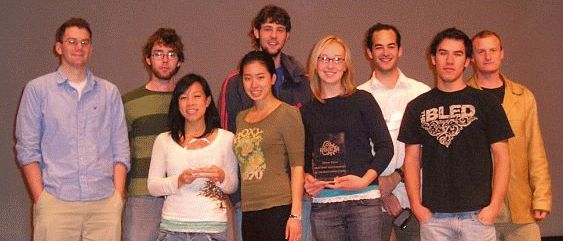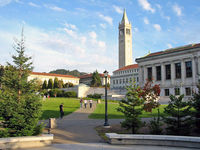University of California Berkeley 2006
From 2006.igem.org
JCAnderson (Talk | contribs) |
|||
| (49 intermediate revisions not shown) | |||
| Line 1: | Line 1: | ||
| - | + | [[Image:Berkeley200BestPartPic.jpg|650px]]<br> | |
| + | ==Awarded:== | ||
| + | '''1st place for Best Part'''<br> | ||
| + | <br> | ||
| + | '''3rd place for Best Measurement and Part Characterization'''<br> | ||
| + | <br> | ||
| + | ==Special Thanks:== | ||
| + | [[Image:Microsoft_Logo.jpg|right|200 px]] | ||
| + | ''The Berkeley iGEM team very gratefully acknowledges the generous support of Microsoft, which helped make our team members' participation possible.''<br> | ||
| + | <h1>Addressable Conjugation in Bacterial Networks</h1> | ||
| + | [[Image:Berkeley2006School.jpg|left|200px]]Networks of interacting cells provide the basis for neural learning. We have developed the process of addressable conjugation for communication within a network of ''E. coli'' bacteria. Here, bacteria send messages to one another via conjugation of plasmid DNAs, but the message is only meaningful to cells with a matching address sequence. In this way, the Watson Crick base-pairing of addressing sequences replaces the spatial connectivity present in neural systems. To construct this system, we have adapted natural conjugation systems as the communication device. Information contained in the transferred plasmids is only accessable by "unlocking" the message using RNA based 'keys'. The resulting addressable conjugation process is being adapted to construct a network of NAND logic gates in bacterial cultures. Ultimately, this will allow us to develop networks of bacteria capable of trained learning.<br> | ||
| + | {| | ||
| + | |width="180px" style="background: moccasin; border: 1px solid rgb(153, 153, 153)"| | ||
| + | <span style='font-size:12.0pt'>Our Team</span> | ||
| + | <hr/> | ||
| + | '''High School''' | ||
| - | ''' | + | Matt Fleming<br> |
| + | Kaitlin A. Davis<br> | ||
| + | |||
| + | '''Undergrads''' | ||
| + | |||
| + | Bryan Hernandez<br> | ||
| + | Jennifer Lu<br> | ||
| + | Samantha Liang<br> | ||
| + | Daniel Kluesing<br> | ||
| + | Will Bosworth<br> | ||
| + | |||
| + | '''Postdocs''' | ||
| - | |||
John E. Dueber<br> | John E. Dueber<br> | ||
| - | + | J. Christopher Anderson<br> | |
| + | |||
| + | '''Faculty Advisors''' | ||
| + | |||
| + | Adam P. Arkin<br> | ||
| + | Jay D. Keasling<br> | ||
| + | |||
| + | |width="20px"| | ||
| + | |width="600px"| | ||
| + | <span style='font-size:12.0pt'> | ||
| + | '''The specific goals of our project were to:'''<br> | ||
| + | |||
| + | <span style='font-size:12.0pt'> | ||
| + | [[Image:Berkeley2006IgemRocks.jpg | 60px]]'''Construct high-performance riboregulator pairs'''<br> | ||
| + | [[Image:Berkeley2006IgemRocks.jpg | 60px]]'''Harness the process of bacterial conjugation'''<br> | ||
| + | [[Image:Berkeley2006IgemRocks.jpg | 60px]]'''Demonstrate transmission of a coded message'''<br> | ||
| + | [[Image:Berkeley2006IgemStillRocks.jpg | 60px]]'''Construct a bacterial learning network'''<br> | ||
| + | </span> | ||
| + | <hr/> | ||
| + | To learn more about our system, follow the series of descriptions below: | ||
| + | |||
| + | <span style='font-size:15.0pt'> | ||
| + | [[Berkeley2006-RiboregulatorsMain | High-performance Riboregulators]] <br> | ||
| + | |||
| + | |||
| + | <span style='font-size:15.0pt'> | ||
| + | [[Berkeley2006-ConjugationMain | Harnessing Bacterial Conjugation]] <br> | ||
| + | |||
| + | |||
| + | <span style='font-size:15.0pt'> | ||
| + | [[Berkeley2006-PromoterMain | Controlling Message Sending and Receiving]] <br> | ||
| - | ' | + | <span style='font-size:15.0pt'> |
| - | + | [[Berkeley2006-PlasmidPartsMain | New Biobrick-Compatible Plasmids]] <br> | |
| - | + | ||
| - | + | ||
| - | + | ||
| - | + | ||
| - | + | ||
| - | [[ | + | |
| + | <span style='font-size:15.0pt'> | ||
| + | [[Berkeley2006-NandMain | Logic Computation in Bacterial Networks]]<br> | ||
| - | |||
| - | + | <span style='font-size:15.0pt'> | |
| - | + | [[Berkeley2006-NetworksMain | Trained Learning in a Bacterial Network]] <br> | |
| - | [[ | + | |
| - | + | ||
| - | + | ||
| - | + | ||
| - | + | ||
| - | |||
| - | + | |} | |
| - | [http:// | + | ---- |
| + | To view our notebooks and protocols, visit our working website at [http://openwetware.org/wiki/IGEM:UC_Berkeley/2006 Berkeley 2006 iGEM]<br> | ||
| + | See our parts list at [http://partsregistry.org/cgi/partsdb/pgroup.cgi?pgroup=iGEM2006partsregistry.org/cgi/partsdb/pgroup.cgi?pgroup=iGEM2006&group=Berkeley Registry 2006 Berkeley iGEM]<br> | ||
| + | Download our [[Media:Berk2006iGEM.ppt | Powerpoint presentation ]]<br> | ||
Latest revision as of 15:05, 15 April 2007
Awarded:
1st place for Best Part
3rd place for Best Measurement and Part Characterization
Special Thanks:
The Berkeley iGEM team very gratefully acknowledges the generous support of Microsoft, which helped make our team members' participation possible.
Addressable Conjugation in Bacterial Networks
Networks of interacting cells provide the basis for neural learning. We have developed the process of addressable conjugation for communication within a network of E. coli bacteria. Here, bacteria send messages to one another via conjugation of plasmid DNAs, but the message is only meaningful to cells with a matching address sequence. In this way, the Watson Crick base-pairing of addressing sequences replaces the spatial connectivity present in neural systems. To construct this system, we have adapted natural conjugation systems as the communication device. Information contained in the transferred plasmids is only accessable by "unlocking" the message using RNA based 'keys'. The resulting addressable conjugation process is being adapted to construct a network of NAND logic gates in bacterial cultures. Ultimately, this will allow us to develop networks of bacteria capable of trained learning.|
Our Team High School Matt Fleming Undergrads Bryan Hernandez Postdocs John E. Dueber Faculty Advisors Adam P. Arkin |
The specific goals of our project were to:
To learn more about our system, follow the series of descriptions below:
High-performance Riboregulators
|
To view our notebooks and protocols, visit our working website at [http://openwetware.org/wiki/IGEM:UC_Berkeley/2006 Berkeley 2006 iGEM]
See our parts list at [http://partsregistry.org/cgi/partsdb/pgroup.cgi?pgroup=iGEM2006partsregistry.org/cgi/partsdb/pgroup.cgi?pgroup=iGEM2006&group=Berkeley Registry 2006 Berkeley iGEM]
Download our Powerpoint presentation


